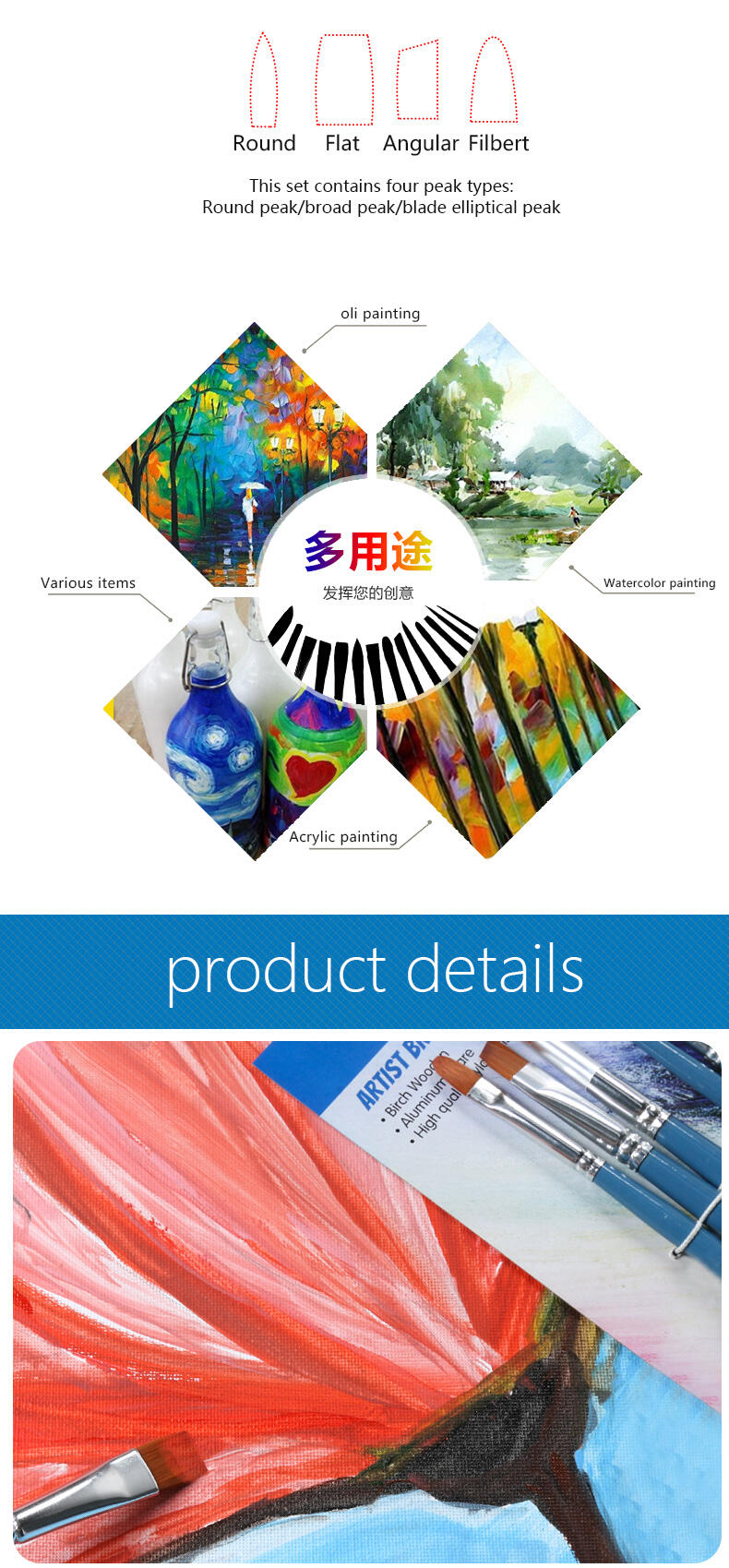Mastering the Versatility of Professional Paint Brushes
Understanding how to effectively utilize a paint brush set is fundamental to achieving both precise details and sweeping broad strokes in your artwork. Whether you're a beginner artist or a seasoned professional, the right technique with your paint brush set can transform your creative vision into reality. The key lies in recognizing how each brush type serves a specific purpose while working in harmony with the others to create cohesive artistic pieces.
Professional artists know that the magic happens when you can seamlessly transition between detailed work and broader applications. This comprehensive guide will explore the intricacies of handling various brushes within your paint brush set, helping you develop the skills needed for versatile painting techniques.
Essential Components of a Quality Paint Brush Set
Understanding Brush Types and Their Purposes
A comprehensive paint brush set typically includes several key brush types, each designed for specific techniques. Flat brushes excel at creating broad, even strokes and are perfect for covering large areas or creating straight edges. Round brushes, with their pointed tips, are ideal for detail work, lines, and precise control. Filbert brushes, with their rounded edges, offer a unique blend of broad coverage and detail capability.
Fan brushes add texture and can create special effects like clouds or foliage, while angle brushes excel at both broad strokes and detailed work, making them particularly versatile. Understanding these different brush types helps you select the right tool for each aspect of your painting.
Bristle Materials and Their Applications
The bristle material in your paint brush set significantly impacts your painting experience. Natural bristles, often made from animal hair, work exceptionally well with oil paints, providing superior paint holding capacity and smooth application. Synthetic bristles, typically made from nylon or polyester, are perfect for acrylic and watercolor paints, offering excellent spring and durability.
Each bristle type responds differently to various painting techniques. Natural bristles tend to be softer and more flexible, ideal for blending and creating smooth transitions. Synthetic bristles maintain their shape better and are more resistant to harsh chemicals, making them perfect for detailed work and techniques requiring more control.
Techniques for Detailed Work
Precision Control Methods
Achieving precise details requires specific handling techniques with your paint brush set. Hold your brush near the ferrule (the metal part) for maximum control when working on fine details. This grip allows for more precise movements and better pressure control. Using the tip of your brush, practice making thin lines and small dots to develop better control.
When working on intricate areas, rest your hand on the canvas or use a mahl stick to steady your movements. This support system helps maintain precision while preventing fatigue during long painting sessions. Remember to clean your brushes frequently during detailed work to maintain sharp edges and prevent color mixing.
Brush Selection for Fine Details
For detailed work, select brushes from your paint brush set that have a fine point or sharp edge. Small round brushes (sizes 0 to 2) are excellent for precise lines and tiny details. Liner brushes, with their extra-long bristles, are perfect for creating continuous fine lines and adding delicate elements to your work.
Consider the paint consistency when working on details. Slightly thinned paint often works better for fine work, allowing for smoother application and better control. Test different brushes and paint consistencies on a separate surface before applying them to your main piece.

Mastering Broad Stroke Techniques
Large Area Coverage Strategies
When covering large areas with your paint brush set, proper technique ensures even coverage and professional results. Load your brush adequately but avoid overloading, which can lead to drips and uneven application. Use broad, confident strokes, maintaining consistent pressure throughout the movement.
Working in sections helps maintain a wet edge, preventing visible lap marks in your final piece. For especially large areas, consider using the largest appropriate brush from your set to maintain efficiency while ensuring even coverage. Remember to work from top to bottom and maintain a systematic approach to avoid missing spots.
Blending and Gradation Methods
Creating smooth transitions and gradients requires specific techniques with your paint brush set. Use medium to large flat brushes for initial color application, then blend edges with a clean, dry brush or one slightly dampened with your medium. Cross-hatching techniques can help create subtle color variations and texture.
For seamless blending, work while your paint is still wet and use light, feathering strokes at the edges where colors meet. Practice circular motions for smooth transitions, and don't be afraid to layer colors gradually to achieve the desired effect.
Maintenance and Care
Cleaning and Storage Practices
Proper maintenance of your paint brush set extends its life and ensures consistent performance. Clean brushes thoroughly after each use, using appropriate solvents for your paint type. Shape the bristles while wet and allow brushes to dry horizontally or hanging downward to prevent water from seeping into the ferrule.
Store brushes either lying flat or standing upright with bristles facing up. Never leave brushes soaking in water or solvents, as this can damage the bristles and loosen the ferrule. Consider using brush guards to maintain brush shapes during storage.
Extending Brush Lifespan
To maximize the longevity of your paint brush set, develop good habits during use. Avoid pressing too hard or spreading the bristles excessively, which can cause permanent damage. Clean brushes immediately after use, and never let paint dry on the bristles.
Regular conditioning of natural bristle brushes helps maintain their flexibility and shape. Invest in proper brush soap or conditioner, and periodically deep clean your brushes to remove built-up residue. These practices ensure your brushes remain effective tools for both detailed work and broad strokes.
Frequently Asked Questions
How Often Should I Replace Brushes in My Paint Brush Set?
The lifespan of brushes varies depending on usage frequency and care. With proper maintenance, quality brushes can last several years. Replace brushes when they start losing their shape, shedding bristles extensively, or no longer maintain a fine point for detailed work.
Can I Use the Same Paint Brush Set for Different Paint Types?
While it's possible to use brushes across different mediums, it's best to dedicate specific brushes to particular paint types. This prevents cross-contamination and ensures optimal performance, as different paints require different bristle properties for best results.
What's the Best Way to Clean Brushes Between Colors During a Painting Session?
For quick color changes, use a paper towel to wipe excess paint, then rinse in appropriate solvent (water for acrylics, mineral spirits for oils). For more thorough cleaning between colors, use mild soap and water, ensuring all paint is removed before switching to a new color.


